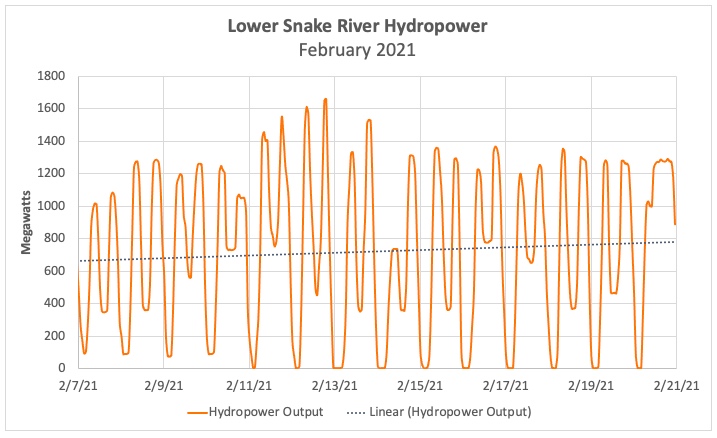forum
library
tutorial
contact

A Carbon Free, Renewable Resource
Faces Extinction
by Dave Markham
Bend Bulletin, August 2, 2022
|
the film forum library tutorial contact |

|
A Carbon Free, Renewable Resource
by Dave Markham
|
Dams and fish can co-exist.
 The lower Snake River dams -- a critical component of the Federal Columbia River Power System -- play an essential role in keeping the lights on for millions of consumers in the Northwest.
The lower Snake River dams -- a critical component of the Federal Columbia River Power System -- play an essential role in keeping the lights on for millions of consumers in the Northwest.
The dams helped prevent blackouts during extreme weather events, like last year's Willamette Valley ice storms and the Northwest heat dome. The dams consistently provide electricity year-round while Texas and California struggle to meet peak energy demands.
The LSRD provide carbon-free electricity -- on demand -- filling the gaps for intermittent renewables like solar and wind, helping the region meet its clean energy and climate goals.
The dams deliver these critical attributes while helping keep consumer rates affordable.
Yet, this valuable resource faces extinction.
The federal Bonneville Power Administration, the United States Bureau of Reclamation and the Army Corps of Engineers released their 2020 Columbia River Systems Operations final Environmental Impact Study. It cited the dams' value and the adverse impacts should they be removed. Loss of clean, reliable power. Substantial increase in power-related carbon emissions. Significant increase in wholesale electricity rates. Double the risk of blackouts.
As for the fish? The EIS showed dam breaching could have little effect on improving salmon returns on the Snake River, dispelling the faulty assertion that the only way to have a healthy fish population is without the dams. Dams and fish can co-exist.
(bluefish counters: below excerpt from EIS does not support the above statement)
Dissatisfied with the multi-federal agencies' conclusions, Gov. Jay Inslee and Sen. Patty Murray announced yet another process, apparently hoping for an answer more appealing to anti-dam activists.
Their commissioned draft report concluded there is a path forward without the dams, but at a steep cost, up to $27 billion to replace the lost benefits, including power. However, the report acknowledges many omitted costs. Notably, the cost of building new transmission lines needed to deliver the electricity was excluded, which could add tens of billions more to the price tag. Who pays? Ratepayers or taxpayers.
Their report fails to paint a complete picture. Replacing this resource would require a fossil-fueled generation to support the intermittency of wind and solar, injecting 5 to 8.5 million metric tons of carbon dioxide into the atmosphere, undermining Oregon and Washington's aggressive carbon reduction goals.
Nor does their report offer real answers to meet the region's energy needs, except to hope for technological breakthroughs. Battery storage technology has not advanced to a point where it can provide enough energy to get the Northwest through an extended arctic blast or heat dome.
The Murray-Inslee effort found an ally in the White House's Council on Environmental Quality. The CEQ rarely weighs in on BPA issues. But, it solicited the National Oceanic Atmospheric Administration Fisheries to write an opinion paper dependent on scientific input from two anti-dam proponents, including the State of Oregon, which sued the federal government to get the dams breached.
The paper's conclusions run contrary to NOAA's modeling in the 2020 CRSO-EIS, which indicated dam breaching could have little effect on improving salmon returns.
The CEQ also interfered and delayed BPA releasing an independent power replacement study conducted by Energy+Environmental & Economics. That study showed a $77 billion price tag to replace the power provided by the dams, including transmission costs. The E3 study finally saw the light on the same day CEQ released NOAA's opinion paper, receiving scant coverage, while the NOAA paper dominated the headlines.
The E3 report also showed that the region would have to rely on more carbon-intensive resources or future technological breakthroughs, like small modular nuclear reactors and "green" hydrogen; not something you want to bet on for grid reliability.
Public power customers could expect rate increases of up to 65% under the higher-end scenario. Senior citizens and those on fixed incomes should not have to endure blackouts nor choose between medicine, food, or paying their electric bills.
Say no to breaching the dams and yes to keeping a reliable, carbon-free, affordable energy resource online.
Executive Summary
Columbia River System Operations
Environmental Impact StatementMO3 (the multi-objective centered around LSRD breaching) predicts the highest benefits among all of the alternatives for ESA-listed salmon in the Snake River and could, in the long-term, provide additional riverine type recreational opportunities.
...
Both salmon and steelhead models, CSS and the LCMs, align in their prediction that MO3 would have the highest potential benefits for Snake River salmon and steelhead.
...
The CSS model predicts that juvenile spring/summer-run Chinook salmon migrating downstream from Lower Granite Dam would return to Lower Granite Dam as adults (SARs) at an increase of 170% relative to the No Action Alternative.
learn more on topics covered in the film
see the video
read the script
learn the songs
discussion forum
